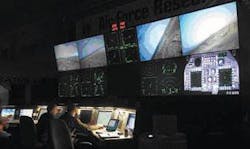By John McHale
ALAMEDA, Calif.—U.S. Air Force officials are using image processors from RGB Spectrum for new aircraft training simulators. The RGB QuadView multiimage display processors will be used in the U.S. Air Force Distributed Mission Operating Training Research (DMOTR) program for Air Force active-duty and reserve forces, as well as the Air National Guard.
Air Force officials implemented the DMOTR program to research, design, and test simulation technologies and learning methods and strategies, company officials say. The DMOTR program is run by the Air Force Research Lab (AFRL) Warfighter Readiness Research Division in Mesa, Ariz., with a team of government and private contractors.
“The F-16 Fighting Falcon is the predominant fighter aircraft used by the U.S. Air Force,” AFRL officials say. “The distributed mission training research test bed includes four cockpits with a high-fidelity 360-degree field of view, which faithfully mimics the actual aircraft. We are also exploring less-than-full-fidelity environments and evaluating how much of what kinds of fidelity are required to train specific combat tasks. We have four of these cockpits as well and they enable us to manipulate the cockpit, tactical, and visual environments to evaluate alternatives and to quantify what those alternatives do to impact training and mission success.
The RGB QuadView multiimage display processors will be used for the U.S. Air Force’s (Active Duty, Air National Guard, and Reserves) Distributed Mission Operating Training Research (DMOTR) program.
“The challenge in designing the displays system for the control room was that we had to accommodate a large number of visual data sources of varying types and centralize them on large screens for real-time viewing,” officials say. “To perform this task, we selected RGB Spectrum’s QuadView multiimage display processor. The QuadView processor was the ideal solution for displaying the extensive image content we required.”
The QuadView processors support as many as 16 switched input sources. The processors are fed an array of high-resolution computer imagery, including cockpit instrumentation data displays, navigation, threat assessment, target acquisition, weapons control, and battle damage assessment data, and communication and network IT information between fighter aircraft. The processors consolidate the image sources—as many as up to four per screen—and output them to Barco rear-screen projectors. Operators can switch image sources, resize, and reposition each image, overlap images, and zoom and pan within each image to focus on a particular area of interest.
“The QuadView performs admirably,” researchers say. “The image quality is excellent, with crisp, readable imagery, down to the finest detail. The QuadView technology makes it finally possible to present intricate data to control center personnel and pilots during debriefings. It is a key component that allows us to provide improved training methodologies.”

